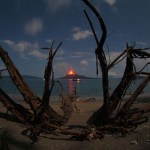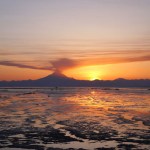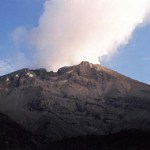indonesia
This is likely my last update until the end of next week sometime, so feel free to use it for any new volcano news you might see. Look for the Erebus Volcano Profile to be posted on Friday sometime, followed by the vote for the next Profile. Next time I post I'll be (back) in the eastern time zone!
With that, I leave you with the latest USGS/SI Weekly Volcano Report.
Highlights (not counting Shiveluch) include:
Small ash plumes were spotted several times from Batu Tara in Indonesia.
Explosions, ashfall and earthquakes were reported at Nevado del Huila in Colombia.
There were reports of…
Your volcano news!
Thanks, as always, to the USGS/SI Global Volcanism Program.
Highlights include:
The alert level at Sakurajima was raised from 2 to 3 by the Japanese Meteorological Agency. This was due to the increasing frequency of explosions at the volcano, some of which produced ash plumes up to 1.8-2.7 km / 6-9,000 feet.
Ash was reported up to 3 km away from Ibu in Indonesia. However, officials in Indonesia lowered the alert from 3 to 2, but tourists are still restricted from going with 2 km of the volcano.
Lots of activity at Shiveluch in Kamchatka. You can see some of the activity in…
Some of the articles you might have missed this week ...
A lava flow from Kilauea breaks local traffic laws in the Royal Gardens subdivision, Hawai'i
The Mayon Watch continues in the Philippines. No eruption yet, but some of the local newspapers are printing stories talking about "odd animal behavior" and other local "myths" about predicting the volcano, such as the wells drying up. Now, this is not to say that these things might have some predictive value (especially changes in the water table near the volcano as it inflates/deflates), but so far there are no robust scientific studies that…
Anak Krakatau erupting as seen from Rataka Island. Image taken by Marco Fulle of Stromboli Online.
I frequent the Astronomy Picture of the Day website run by NASA on a daily basis. Yet somehow today I didn't check the site until well into the evening and was greeted by one of the best astronomy-volcano images I've seen in a while. Marco Fulle of Stromboli Online captured this image of Anak Krakatau erupting (in 2008 or 2009 ... its unclear in the caption) with Ursa Major rising over the volcano. There have been quite a few volcano-related images on APOD, but alas, they don't have a "volcano…
All the volcano news that is fit to print, all thanks to the USGS/Smithsonian GVP!
Highlights (not include Manda Hararo, Kilauea and Mayon) include
San Miguel in El Salvador has been experiencing increased seismicity. The last time the volcano erupted was in 2002.
A pilot spotted a ~10,000 foot / 3 km ash plume emanating from Anak Krakatau in Indonesia.
Another ash plume, this time at Ubinas, Peru, was spotted by pilots rising to ~6.7-9.1 km / 20-30,000 feet.
Explosions were heard from Suwanose-jima in Japan, but no associated ash plumes were spotted.
It sounds like a lava dome has been…
Two papers submitted, one to go. Keeps you quite busy, let me tell you.
Lava flow from a 2006 eruption on Mayon in the Philippines.
A few bits of news today:
A few more details about the ongoing watch of Mayon in the Philippines . There have been apparently no changes in the shape of the floor of the crater as you might expect if magma was rising underneath. However, there has been an overall inflation of Mayon since the unrest began a few weeks ago. PHIVOLCS will be checking the sulfur dioxide and carbon dioxide output of the volcano soon as well.
Lots of articles this week about the "…
A few quick news bits ... and thanks for the questions so far. Keep 'em coming!
Tungurahua, Ecuador erupting in 2006.
Ash fall from Tungurahua (in spanish) in Ecuador is affecting the farm towns around the volcano. Farmers in Manzano, a village nearby, fear the ash is significant enough to damage their crops. The volcano itself is throwing incandescent bombs near the vent along with producing copious ash.
There is a nice piece in the News Tribune about how Alaska Airlines handled the eruption of Mt. Redoubt near Anchorage this March. It is nice to get some insight into how airlines deal…
Some volcano news before the weekend:
The Barujari vent at Mt. Rinjani erupting in May 2009.
Barujari, the small basaltic volcano located in the crater at Mt. Rinjani, is "spewing 200-meter-high lava", at least according to recent reports. It is unclear if the eruption is, in fact, a fountain or merely strombolian activity throwing incandescent blocks that high (see above). My guess is that it is the latter, as that is much more typical for Barujari. Another report mentions a 600 meter "river of lava" (in spanish) that ends at Segara Anak lake. The volcano has been erupting all spring with…
Your weekly dose of volcano news brought you by the Smithsonian Institute GVP and the USGS.
This week's highlights (not counting Sarychev Peak and Turrialba) include:
13,000 foot / 4 km ash plumes from Rinjani in Indonesia. This is part of the continuing eruption there.
The alert level was lowered at Galeras, Colombia to "Orange" after intense eruptions last week.
The current lava dome at Redoubt is 1 km long, 460 m wide, and 200 m high according to the latest images from the Alaskan volcano.
18,000-23,000 foot / 4.8-7.7 km ash plumes from Shiveluch in Kamchatka, along with thermal anomalies…
I won't try to recap all the news from last week, but I did notice a few articles from this weekend worth noting:
The Big Obsidian Flow at Newberry Volcano. This rhyolite lava flow erupted at ~1,300 years ago.
Geologists in Greece are keeping an eye on a submarine volcano called Columbus. Apparently a number of M4+ earthquakes have been reported, the sea floor has deformed and there have been "hot air eruption" (? ... I am a little skeptical of the last one without more details). The article is a little fuzzy on the details: the volcano is 6.5 meters southeast of Santorini and the Santorini…
This will likely be my last new post for the next week or so. I'll be off to my home town for a wedding and a reunion. If you're jonesing for up to date volcano info, be sure to visit the Volcanism Blog or the European Volcanological Society news page. Feel free to post any other links you know or breaking volcano news over on the open thread as well! I will be posting a couple pieces over this next week, including the next volcano profile, so stay tuned for those as well. Regular posting of new volcano news should return June 15.
Mt. Redoubt in Alaska steaming in spring 2009. Image courtesy…
We've already talked about how many active volcanoes reside in Indonesia, but this week's USGS/SI update just drives that point home. Listed in the update are no less than 5 volcanoes were activity is being seen or is on the increase (Karangetang, Slamet, Dukono, Batu Tara and Makian). This doesn't mean mention the activity at Anak Krakatau, Rinjani or Semeru. Amazing.
Anyway, highlights - not counting Indonesia or the South American trio - from this week's report (as usual aptly put together by Sally Kuhn Sennert) include:
A ~8,000 foot / 2.4 km ash and steam plume from Bagana in Papua New…
Karangetang in Indonesia erupting during the mid 1990s. Image courtesy of VolcanoWorld.
The alert level at Karangetang, one of the most active volcanoes in Indonesia, was raised to Orange over the weekend and people living near the volcano have been evacuated. The volcano is apparently already producing ash and lava flows, but it is mostly the ash hazard that is prompting the evacuations. Karangetang erupts almost every year and sometimes with deadly consequences, as in 1992 when 6 settlers near the volcano perished.
Here's some news bits for all you volcanophiles. Enjoy the weekend!
Ubinas in Peru steaming away in June 2007. Image courtesy of Eruptions reader Mike Lyvers.
There has been a lot of press lately on the theory that a large eruption from an ancient volcanic field in China (the 260-million-year-old Emeishan volcanic province of southwest China) could be the culprit in the grand Permian extinction. I have to admit, I've only skimmed the surface of this study, but the work lead by Dr. Paul Wignall (a paleontologist, not a volcanologist - not that there is anything wrong with that) seems to…
Your weekly dose of volcanic activity from the USGS/SI. (a little late thanks to an exciting day of column chemistry).
Some highlights include:
A 3.7 km / 12,000 foot ash plume from Karangetang in Indonesia (great name, eh?)
Lava flows, ash plumes and local ash falls from Slamet in Indonesia.
White and grey ash plumes rises to ~4 km / 13,000 feet from Colima, Mexico.
Blocks up to 2-m across were transported by lahars from Fuego in Guatemala. The volcano also produced ~4.6 km / 14,500 foot ash plumes.
Small ash plume spotted at Barren Island in the Andaman Islands of India.
You'll have to excuse the curtness of this post. An bad hop in softball will do that to you.
Here's some news:
Mt. Dempo in Indonesia
Xinhua offers some nice pictures of the current activity going on at the summit crater at Nyiragongo in the Congo. Note the partially-crusted-over lava lake in the first shot. The Red Cross is updating the evacuation and mitigation plans for the area as the volcano shows increased activity.
The alert level at Mt. Dempo in Indonesia was raised to the second highest level. There has been ash fall (as far as 10 km from the vent) and volcanic gas emissions. The…
Things are busy - both volcanically and personally - so I'm going to just give you some links to a bunch of exciting/interesting/insane news:
West Mata erupting on May 5, 2009 in the Lau Basin.
According to a bunch of news sources, the eruption at Fernandina in the Galapagos is over (in spanish). That being said, the PNG noted that there is still a lot of carbon dioxide and sulfur dioxide being emitted, suggesting there is still a lot of degassing magma beneath the vents - at what depth (and will it erupt) is the question.
There is a lot of speculation that Nyiragongo (DRC) is erupting or…
Anak Krakatau in Indonesia.
Eruptive activity is definitely on the uptick at Anak Krakatau. The Jakarta Globe is reporting that the volcano is "spewing molten lava 1000 meters in the air". I'm not entirely sure if that is accurate or that the volcano is throwing volcanic bombs or tephra that high. The head of the Volcanology and Geological Disaster Mitigation Center in Indonesia, merely referred to as Surono in the article (are we playing Brazilian soccer?), says that the volcano is "a high threat because the eruptions have started spreading." Again, I'm not too sure what that means, whether…
All the eruptions fit to print from the Smithsonsian/USGS GVP Weekly Report.
A few highlights (not including Redoubt, Rinjani and Slamet):
Multiple ash plumes from Galeras (Colombia), some producing noticeable ash fall up to 35 km from the vent.
The Alert Level at Anak Krakatau, Indonesia was raised to 3 (out of 4) after a sharp increase in the number of explosions.
The Alert Level at Cleveland in Alaska was lowered from Yellow to "Unassigned" (no Green for Cleveland as there is no real-time seismic network for the volcano, thus no "background levels" to compare.)
Ebeko in Russia continues…
Some brief tidbits from the volcanic realms:
Active volcanism at NW Rota-1
Kilauea? Explosive? You might think of Kilauea as a volcano that generates impressive Hawaiian-style eruptions with fire fountains reaching 100s m and dazzling lava flows, but Don Swanson at HVO sees evidence of a big explosive event at Kilauea. This eruption was ~1,000-1,600 years ago and may have produced a plinian-scale eruptive column and threw cm-scale chunks up to 17 km from the vent.
The intermingling of life and active volcanism always seems counterintuitive, but when you're talking undersea volcanism, all…


